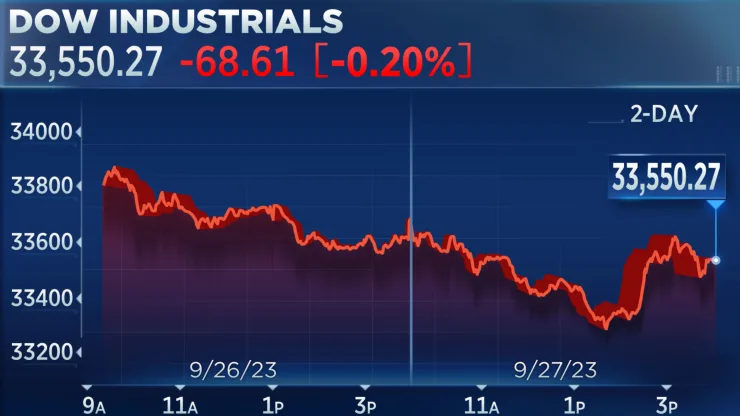The Dow Jones Industrial Average, a key indicator of the US stock market’s performance, faced another challenging day on Wednesday, extending its losses from the previous session.
Investors grappled with an uptick in Treasury yields and soaring oil prices, which put a damper on market sentiment.
In this blog post, we’ll delve into the factors contributing to the Dow’s decline, the performance of other major indices, and what investors can expect in the near future.
Dow Jones Takes a Hit
On Wednesday, the Dow Jones Industrial Average dropped 68.61 points, or 0.20%, closing at 33,550.27. Earlier in the trading session, the index had briefly surged by 112.77 points before losing ground.
This decline followed a substantial loss on Tuesday when the Dow recorded its most significant one-day drop since March, falling more than 300 points and closing below its 200-day moving average for the first time since May.
The S&P 500 managed to eke out a marginal gain of 0.02%, finishing at 4,274.51, while the Nasdaq Composite showed a modest increase of 0.22%, closing at 13,092.85.
Rising Yields and Oil Prices
One of the primary factors impacting investor sentiment was the surge in Treasury yields. The benchmark 10-year Treasury yield reached its highest levels since 2007, causing concerns among investors.
The 2-year Treasury yield also climbed. Simultaneously, US crude oil futures experienced a significant jump of more than 3%, settling at $93.68 per barrel.
These developments had a cascading effect on the markets, leading to uncertainty and caution among investors.
Energy Sector Outperforms
Despite the broader market downturn, the energy sector emerged as the day’s winner, posting a 2.5% gain. Notable gainers in this sector included Marathon Oil and Devon Energy, both of which saw their stocks rise by more than 4%.
The energy sector’s resilience in the face of market volatility was partly due to the spike in oil prices, benefiting energy companies and their stocks.
Inflation Concerns Loom
Greg Bassuk, CEO of AXS Investments, pointed out that inflation remains a significant concern for investors.
He highlighted the anxiety surrounding not only elevated inflation rates but also their impact on companies dealing with higher borrowing costs. This concern is one of the key drivers of recent market turbulence.
September’s Seasonal Weakness
It’s important to note that September historically tends to be a weak month for stocks, and this year was no exception. The S&P 500 was down by 5% month-to-date, while the Dow Jones declined more than 3%.
The Nasdaq Composite, often associated with technology stocks, experienced the most significant setback, losing over 6% in September.
What’s on the Horizon
Despite the current challenges, Greg Bassuk anticipates that market volatility could persist in the coming weeks. However, he remains optimistic about potential buying opportunities in late October leading up to the end of the year.
Investors should closely monitor economic indicators, central bank policies, and global events to make informed decisions in this dynamic market environment.
The Dow Jones Industrial Average faced a setback as rising Treasury yields and oil prices weighed on investor sentiment.
While September has historically been a weak month for stocks, market participants should keep a watchful eye on various economic factors and remain agile in their investment strategies to navigate the evolving market landscape.

